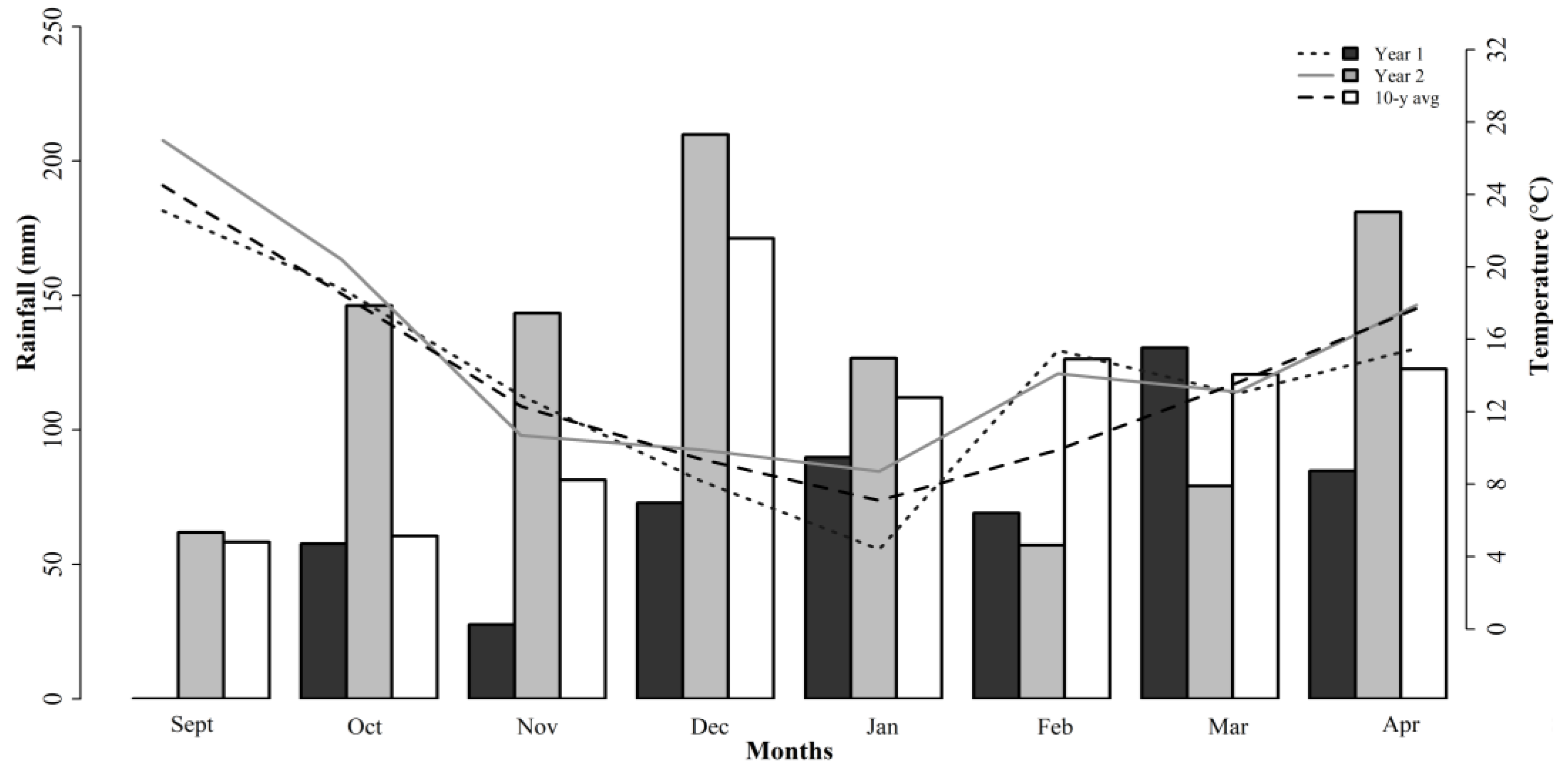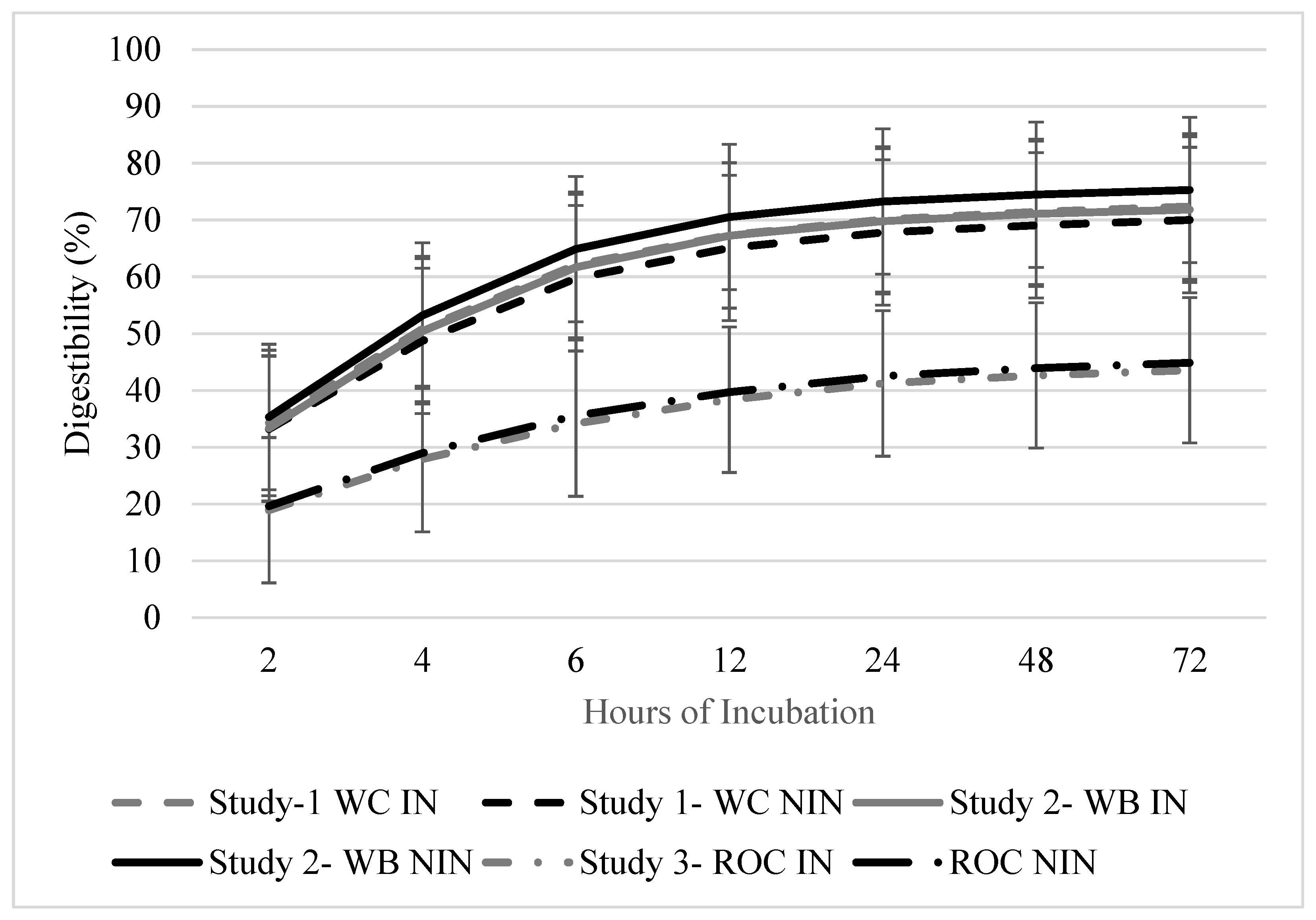In Situ Ruminal Digestion, Fermentation Parameters, and Forage Nutritive Value of Cool-Season Baleage Ensiled under Contrasting Inoculant Strategies
Abstract
Simple Summary
Abstract
1. Introduction
2. Materials and Methods
2.1. Study Location
2.2. Forage Mixture Establishment
2.3. Experimental Design
2.4. Determination of Nutritive Value
2.5. Determination of In Situ Disappearance of DM
2.6. Statistical Methods
3. Results
3.1. Botanical Composition
3.2. Nutritive Value
3.3. Fermentation Parameters
3.4. Dry Matter Disappearance
4. Discussion
5. Conclusions
Supplementary Materials
Author Contributions
Funding
Institutional Review Board Statement
Informed Consent Statement
Data Availability Statement
Acknowledgments
Conflicts of Interest
References
- Dillard, S.L.; Hancock, D.W.; Harmon, D.D.; Mullenix, M.K.; Beck, P.A.; Soder, K.J. Animal performance and environmental efficiency of cool- and warm-season annual grazing systems. J. Anim. Sci. 2018, 96, 3491–3502. [Google Scholar] [CrossRef] [PubMed]
- Panhans, M.H.; Mason, K.M.; Mullenix, M.K.; Prevatt, C.G.; Moisá, S.J.; Muntifering, R.B. Cow–calf performance, forage utilization, and economics of warm-season annual baleage in beef cattle winter feeding systems. Transl. Anim. Sci. 2020, 4, 376–384. [Google Scholar] [CrossRef] [PubMed]
- Sears, B.; Teutsch, C.; Smith, R.; Henning, J.C.; Hancock, D.W. Baleage: Frequently Asked Questions. 2013. Available online: http://www2.ca.uky.edu/agcomm/pubs (accessed on 10 April 2019).
- Hancock, D.W.; Saha, U.; Stewart, R.L.; Bernard, J.K.; Smith, R.C.I.; Johnson, J.M. Understanding and improving forage quality. UGA Ext. Bull. 2017, 1425, 9. [Google Scholar] [CrossRef]
- Lemus, R. Utilizing Baleage As an Alternative Way to Maintaining Forage Quality. Forage News: 1–6. 2010. Available online: https://extension.msstate.edu/sites/default/files/newsletter/forage-news/2010/2.pdf (accessed on 10 April 2019).
- Muck, R.E. Silage microbiology and its control through additives. Rev. Bras. Zootec. 2010, 39, 183–191. [Google Scholar] [CrossRef]
- Kung, L.; Shaver, R.D.; Grant, R.J.; Schmidt, R.J. Silage review: Interpretation of chemical, microbial, and organoleptic components of silages. J. Dairy Sci. 2018, 101, 4020–4033. [Google Scholar] [CrossRef] [PubMed]
- Driehuis, F.; Elferink, S.J.W.H.O.; van Wikselaar, P.G. Fermentation characteristics and aerobic stability of grass silage inoculated with Lactobacillus buchneri, with or without homofermentative lactic acid bacteria. Grass Forage Sci. 2001, 56, 330–343. [Google Scholar] [CrossRef]
- McCormick, M.E.; Cuomo, G.J.; Blouin, D.C. Annual ryegrass stored as baleage, haylage, or hay for lactating dairy cows. J. Prod. Agric. 1998, 11, 293–300. [Google Scholar] [CrossRef]
- Mitchell, C.C. Nutrient Recommendation Tables for Alabama Crops. Agronomy and Soils Departmental Series no 324B. 2011. Available online: https://www.aces.edu/wp-content/uploads/2019/01/ANR-0449.REV_.3.pdf (accessed on 3 January 2018).
- Ball, D.M.; Hoveland, C.S.; Lacefield, G.D. Southern Forages: Modern Concepts for Forage Crop Management, 5th ed.; International Plant Nutrition Institute: Ithaca, NY, USA, 2015. [Google Scholar]
- AOAC. Official Methods of Analysis, 18th ed.; AOAC: Arlington, VA, USA, 2006. [Google Scholar]
- Carlson, R.M. Automated separation and conductimetric determination of ammonia and dissolved carbon dioxide. Anal. Chem. 1978, 50, 1528–1531. [Google Scholar] [CrossRef]
- Dairy ONE Forage Laboratory. Analytic Procedures. 2022. Available online: https://dairyone.com/download/forage-forage-lab-analytical-procedures/?wpdmdl=13889&refresh=60901a7e3542f1620056702 (accessed on 10 April 2019).
- Van Soest, P.J.; Robertson, J.B.; Lewis, B.A. Methods for dietary fiber, neutral detergent fiber, and nonstarch polysaccharides in relation to animal nutrition. J. Dairy Sci. 1991, 74, 3583–3597. [Google Scholar] [CrossRef]
- Vanzant, E.S.; Cochran, R.C.; Titgemeyer, E.C. Standardization of in situ techniques for ruminant feedstuff evaluation. J. Anim. Sci. 1998, 76, 2717–2729. [Google Scholar] [CrossRef] [PubMed]
- Whittet, K.; Creighton, K.; Erickson, G.E.; Klopfenstein, T.J.; Erickson, G. Influence of Rinsing Technique and Sample Size on In Situ Protein Degradation; Nebraska Beef Cattle Reports; University of Nebraska-Lincoln: Lincoln, NE, USA, 2003; pp. 1–4. [Google Scholar]
- Mertens, D.R.; Loften, J.R. The effect of starch on forage fiber digestion kinetics in vitro. J. Dairy Sci. 1980, 63, 1437–1446. [Google Scholar] [CrossRef]
- SAS Institute. User’s Guide: Statistics, Version 9.4; SAS, Institute Inc.: Cary, NC, USA, 2013. [Google Scholar]
- Widenhoeft, M.H.; Barton, B.A. Management and environment effects on brassica forage quality. Agron. J. 1994, 86, 227–232. [Google Scholar] [CrossRef]
- Dillard, S.L.; Billman, E.D.; Soder, K.J. Assessment of forage brassica species for dairy and beef-cattle fall grazing systems. Appl. Anim. Sci. 2020, 36, 157–166. [Google Scholar] [CrossRef]
- Mason, K.; Mullenix, M.K.; Elmore, J.; Runge, M.; Kelley, W.K. 139 Evaluation of cool-season annuals or reduced labor supplementation systems for wintering cow-calf pairs. J. Anim. Sci. 2019, 97, 8. [Google Scholar] [CrossRef]
- Marchant, K.B.; Dillard, S.L.; Holland, C.E.; Gamble, B.E.; Muntifering, R.B. Stocker cattle performance from grazed mixtures of triticale and wheat with annual ryegrass. Appl. Anim. Sci. 2019, 35, 199–208. [Google Scholar] [CrossRef]
- Dillard, S.L.; Roca-Fernández, A.I.; Rubano, M.D.; Elkin, K.R.; Soder, K.J. Enteric methane production and ruminal fermentation of forage brassica diets fed in continuous culture. J. Anim. Sci. 2018, 96, 1362–1374. [Google Scholar] [CrossRef] [PubMed]
- Bolsen, K.K.; Ashbell, G.; Weinberg, Z.G. Silage fermentation and silage additives—Review. Asian-Australas. J. Anim. Sci. 1996, 9, 483–493. [Google Scholar] [CrossRef]
- Oltjen, R.R. Effects of feeding ruminants non-protein nitrogen as the only nitrogen source. J. Anim. Sci. 1969, 28, 673–682. [Google Scholar] [CrossRef] [PubMed]
- Keim, J.P.; Cabanilla, J.; Balocchi, O.A.; Pulido, R.G.; Bertrand, A. In vitro fermentation and in situ rumen degradation kinetics of summer forage brassica plants. Anim. Prod. Sci. 2018, 59, 1271–1280. [Google Scholar] [CrossRef]
- National Academies of Sciences, Engineering, and Medicine. Nutrient Requirements of Beef Cattle, Eighth Revised ed.; The National Academies Press: Washington, DC, USA, 2016. [Google Scholar] [CrossRef]


| Response Variable | Forage Mixture | |||||
|---|---|---|---|---|---|---|
| Study 1 | Study 2 | Study 3 | ||||
| WC 1 | SEM 2 | WB | SEM | ROC | SEM | |
| DM (%) | 18.9 | 0.58 | 22.4 | 0.37 | 18.5 | 0.29 |
| CP (%) | 17.1 | 0.55 | 13.4 | 0.25 | 15.8 | 0.42 |
| NDF (%) | 49.9 | 1.05 | 51.6 | 1.22 | 63.7 | 0.36 |
| ADF (%) | 30.2 | 0.56 | 29.5 | 0.51 | 39.9 | 0.26 |
| ADL (%) | 5.4 | 0.62 | 4.8 | 0.10 | 5.2 | 0.12 |
| ResponseVariable | Forage Mixture | ||||||||
|---|---|---|---|---|---|---|---|---|---|
| Study 1 1 | Study 2 | Study 3 | |||||||
| IN 2 | NIN | SEM 3 | IN | NIN | SEM | IN | NIN | SEM | |
| DM (%) | 18.3 | 17.9 | 0.58 | 21.7 | 23.0 | 0.37 | 18.4 | 18.6 | 0.29 |
| CP (%) | 17.8 | 16.4 | 0.55 | 13.8 a4 | 13.0 b | 0.25 | 15.0 b | 16.6a | 0.42 |
| NDF (%) | 50.1 | 49.7 | 1.05 | 52.0 | 51.2 | 1.22 | 63.8 | 63.5 | 0.36 |
| ADF (%) | 30.3 | 30.1 | 0.56 | 29.8 | 29.2 | 0.51 | 39.9 | 39.9 | 0.26 |
| ADL (%) | 5.3 | 5.4 | 0.35 | 4.9 | 4.8 | 0.10 | 5.2 | 5.1 | 0.12 |
| Days After Ensiling | DM | CP | NDF | ADF | ADL |
|---|---|---|---|---|---|
| % | |||||
| 0 | 19.6 | 15.1 | 62.2 cde2 | 36.2 e | 4.4 d |
| 7 | 18.1 | 16.1 | 65.1 b | 40.2 bc | 5.4 ab |
| 14 | 19.5 | 17.0 | 61.3 e | 38.4 d | 4.6 cd |
| 21 | 19.4 | 16.6 | 61.6 ed | 39.1 cd | 4.9 bcd |
| 28 | 18.3 | 15.4 | 64.0 bc | 40.1 bc | 5.3 bcd |
| 45 | 18.0 | 13.8 | 64.2 bc | 41.2 bc | 5.4 ab |
| 60 | 18.0 | 15.7 | 63.6 bcd | 40.8 bc | 5.6 ab |
| 120 | 17.3 | 16.7 | 67.5 a | 43.6 a | 6.1 a |
| SEM 1 | 0.57 | 0.84 | 0.72 | 0.52 | 0.25 |
| Response Variable | Forage Mixture | |||||||||||
|---|---|---|---|---|---|---|---|---|---|---|---|---|
| Study 1 1 | Study 2 | Study 3 | ||||||||||
| IN 2 | NIN | SEM 3 | p-Value | IN | NIN | SEM | p-Value | IN | NIN | SEM | p-Value | |
| pH | 4.9 | 4.9 | 0.12 | 0.705 | 4.5 | 4.6 | 0.04 | 0.024 | 5.5 | 5.4 | 0.08 | 0.491 |
| Ammonia (crude protein equivalent %) | 1.6 | 1.9 | 0.22 | 0.393 | 0.6 | 0.7 | 0.05 | 0.441 | 3.7 | 4.0 | 0.19 | 0.366 |
| Ammonia-N (% of Total N) | 8.9 | 11.0 | 1.50 | 0.311 | 4.5 | 5.1 | 0.39 | 0.292 | 25.2 | 24.2 | 1.57 | 0.651 |
| Acetic acid (%) | 5.7 | 2.2 | 0.38 | <0.001 | 5.4 | 1.7 | 0.38 | <0.001 | 3.2 | 3.5 | 0.26 | 0.510 |
| Lactic acid (%) | 2.6 | 5.3 | 0.41 | <0.001 | 2.8 | 4.2 | 0.22 | <0.001 | 0.9 | 1 | 0.16 | 0.641 |
| Propionic acid (%) | 0.4 | 0.2 | 0.07 | 0.012 | 0.1 | 0.1 | 0.09 | 0.021 | 0.5 | 0.4 | 0.05 | 0.485 |
| Butyric acid (%) | 0.3 | 0.9 | 0.33 | 0.221 | 0.1 | 0.2 | 0.04 | 0.008 | 2.5 | 2.4 | 0.11 | 0.981 |
| Isobutyric acid (%) | 0.05 | 0.02 | 0.026 | 0.446 | 0.01 | 0.01 | 0.002 | 0.400 | 0.20 | 0.20 | 0.16 | 0.951 |
Publisher’s Note: MDPI stays neutral with regard to jurisdictional claims in published maps and institutional affiliations. |
© 2022 by the authors. Licensee MDPI, Basel, Switzerland. This article is an open access article distributed under the terms and conditions of the Creative Commons Attribution (CC BY) license (https://creativecommons.org/licenses/by/4.0/).
Share and Cite
Shoup, S.L.; Muntifering, R.B.; Mullenix, M.K.; Silva, L.S.; Dillard, S.L. In Situ Ruminal Digestion, Fermentation Parameters, and Forage Nutritive Value of Cool-Season Baleage Ensiled under Contrasting Inoculant Strategies. Animals 2022, 12, 2929. https://doi.org/10.3390/ani12212929
Shoup SL, Muntifering RB, Mullenix MK, Silva LS, Dillard SL. In Situ Ruminal Digestion, Fermentation Parameters, and Forage Nutritive Value of Cool-Season Baleage Ensiled under Contrasting Inoculant Strategies. Animals. 2022; 12(21):2929. https://doi.org/10.3390/ani12212929
Chicago/Turabian StyleShoup, Sarah Lynn, Russell Brian Muntifering, Mary Kimberly Mullenix, Liliane Severino Silva, and Sandra Leanne Dillard. 2022. "In Situ Ruminal Digestion, Fermentation Parameters, and Forage Nutritive Value of Cool-Season Baleage Ensiled under Contrasting Inoculant Strategies" Animals 12, no. 21: 2929. https://doi.org/10.3390/ani12212929
APA StyleShoup, S. L., Muntifering, R. B., Mullenix, M. K., Silva, L. S., & Dillard, S. L. (2022). In Situ Ruminal Digestion, Fermentation Parameters, and Forage Nutritive Value of Cool-Season Baleage Ensiled under Contrasting Inoculant Strategies. Animals, 12(21), 2929. https://doi.org/10.3390/ani12212929






